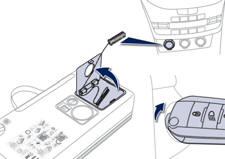Repair procedure

1. Sealing
- Switch off the ignition.
- Turn the selector A to the "sealant" position.
- Check that the switch B is in position "O".

Avoid removing any foreign bodies which have penetrated into the tyre.

- Uncoil the white pipe G fully.
- Unscrew the cap from the white pipe.
- Connect the white pipe to the valve of the tyre to be repaired.
Take care, this product is harmful (e.g. ethylene-glycol, colophony...) if swallowed and causes irritation to the eyes.
Keep it out of reach of children.

- Connect the compressor's electric plug to the vehicle's 12 V socket.
- Start the vehicle and leave the engine running.

Switch on the compressor by moving the switch B to position "I" until the tyre pressure reaches 2.0 bars. The sealant is injected into the tyre under pressure; do not disconnect the pipe from the valve during this operation (risk of splashing).
Do not start the compressor before connecting the white pipe to the tyre valve: the sealant product would be expelled through the pipe.

- Remove the kit and screw the cap back on the white pipe. Take care to avoid staining your vehicle with traces of fluid. Keep the kit to hand.
- Drive immediately for approximately three miles (five kilometres), at reduced speed (between 15 and 35 mph (20 and 60 km/h)), to plug the puncture.
- Stop to check the repair and the tyre pressure using the kit.
If after around 5 to 7 minutes the pressure is not attained, this indicates that the tyre is not repairable; contact a PEUGEOT dealer or a qualified workshop for assistance.

2. Inflation
- Turn the selector A to the "air" position.
- Uncoil the black pipe H fully.
- Connect the black pipe to the valve of the wheel.


- Connect the compressor's electric plug to the vehicle's 12 V socket.
- Start the vehicle again and leave the engine running.
Visit a PEUGEOT dealer or a qualified workshop as soon as possible.
You must inform the technician that you have used this kit. After inspection, the technician will inform you whether the tyre can be repaired or must be replaced.

- Adjust the pressure using the compressor (to inflate: switch B in position "I" ; to deflate: switch B in position "O" and press button C), in accordance with the vehicle's tyre pressure label (located on the left hand door aperture). A loss of pressure indicates that the puncture has not been fully plugged; contact a PEUGEOT dealer or qualified workshop for assistance.
- Remove and stow the kit.
- Drive at reduced speed (50 mph [80 km/h] max) limiting the distance travelled to approximately 120 miles (200 km).
See also:
Homes on wheels
After the summer we have just had, I suspect the great British staycation
could soon become extinct. But if you are made of stern stuff, or merely want to
upgrade from a tent, you may be intereste ...
Front demist - defrost
These markings on the control panel
indicate the control positions for rapid demisting or defrosting of the windscreen
and side windows.
With the heating / ventilation system
Put the temperatur ...
Automatic rain sensitive windscreen wipers
The windscreen wipers operate automatically, without any action on the part of
the driver, if rain is detected (sensor behind the rear view mirror), adapting their
speed to the intensity of the ra ...






